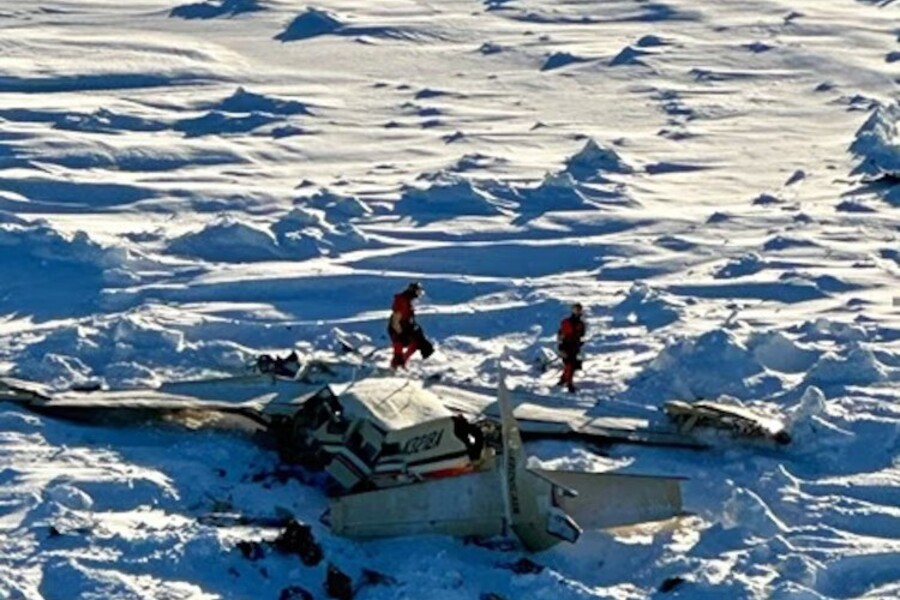The wreckage of Bering Air Flight 445, which went missing on Thursday, has been located, with all ten people on board believed to have perished. The aircraft was discovered on sea ice approximately 34 miles southeast of Nome, Alaska. The U.S. Coast Guard confirmed the grim news after releasing a photograph of the crash site. Search and rescue crews found three bodies inside the plane, while the remaining seven passengers are presumed to still be trapped in the wreckage, which remains inaccessible due to its condition.
The Alaska State Troopers will oversee the recovery efforts. Coast Guard Lieutenant Commander Mike Salerno confirmed that all passengers, including the pilot, are believed to be dead. The wreckage was identified by a search-and-rescue team aboard a USCG MH-60 Jayhawk helicopter. Two rescue swimmers were lowered onto the crash site to survey the scene.
Flight 445, a Cessna 208B, disappeared while flying from Unalakleet Airport to Nome Airport at around 3:20 p.m. local time. Authorities reported that the plane was last tracked 12 miles offshore. Shortly before vanishing from radar, the aircraft experienced a rapid loss of both altitude and speed. Coast Guard spokesperson Ben McIntyre-Coble said radar data suggests an unspecified catastrophic event but declined to speculate on the cause. The plane was officially reported overdue at 4:30 p.m. Thursday, prompting a large-scale search and rescue operation involving multiple agencies.
The aircraft carried nine adult passengers and a pilot, all of whom are feared dead. The search was hindered overnight by severe weather conditions, including freezing temperatures and poor visibility. Despite these challenges, search crews resumed operations at first light on Friday and were able to locate the crash site by mid-morning.
The tragic news has sent shockwaves through Alaska’s remote communities, where aviation is a critical lifeline. Bering Air provides essential transportation services to isolated villages, and many of the passengers were likely residents traveling for work or personal reasons. Mary White, a resident of Nome with family members aboard the flight, described the devastating impact the crash has had on the community. “We’re all heartbroken,” she said. “This isn’t just a tragedy for the families; it’s a loss that touches everyone here.”
The National Transportation Safety Board (NTSB) has launched a formal investigation. NTSB Chair Jennifer Homendy is scheduled to travel to Alaska over the weekend to oversee the inquiry. Investigators will examine flight records, communication logs, and weather data to determine what caused the crash. Although mechanical failure and pilot error are potential factors, officials have not ruled out the role of Alaska’s harsh and unpredictable weather.
The crash is the latest in a series of aviation incidents that highlight the risks of flying in remote regions. Alaska’s rugged terrain, combined with extreme and rapidly changing weather conditions, presents significant challenges for pilots. Mark Johnson, an experienced Alaskan pilot, noted that flying in the region requires constant vigilance. “You can have clear skies one minute and a blizzard the next,” he explained. “That’s the reality we deal with, but when something like this happens, it’s heartbreaking.”
In response to the tragedy, local authorities and advocacy groups are calling for improved safety measures. Suggestions include enhanced weather monitoring and additional pilot training to better prepare for emergencies. However, many Alaskans recognize that aviation will always carry inherent risks in such a challenging environment.
As families mourn the loss of their loved ones, communities across the region have come together to offer support. Vigils are being held in both Nome and Unalakleet, where many of the victims were from. Residents described the passengers as essential members of their communities, including teachers, healthcare workers, and business owners. “They weren’t just passengers; they were our friends, our neighbors,” said one attendee at a memorial service. “Their absence leaves a void that will be hard to fill.”
Bering Air officials expressed their sorrow and pledged full cooperation with investigators. In a statement, the company said it would do everything possible to assist the affected families and support the ongoing investigation. “This is a tragic day for our entire organization and the communities we serve,” the statement read.
Meanwhile, legal and aviation experts are emphasizing the importance of transparency and accountability in the investigation process. Jacob Reinhart, a former aviation safety consultant, stressed the need for thorough analysis to prevent similar tragedies in the future. “We owe it to the victims and their families to understand what went wrong,” he said. “Only by learning from this can we hope to improve safety for all.”
Despite the somber atmosphere, residents are determined to honor the memory of those lost by continuing to support one another. “Alaskans are resilient,” said Lisa Duncan, a Nome resident. “We’ve faced loss and hardship before, but we come together and find strength in each other.”
The crash serves as a painful reminder of the crucial role that aviation plays in connecting Alaska’s remote communities. For many residents, flights like Bering Air’s are not just a convenience but a necessity for accessing healthcare, education, and economic opportunities. As the investigation unfolds, the focus will remain on honoring the victims and ensuring that the lessons learned from this tragedy lead to meaningful improvements in aviation safety.

